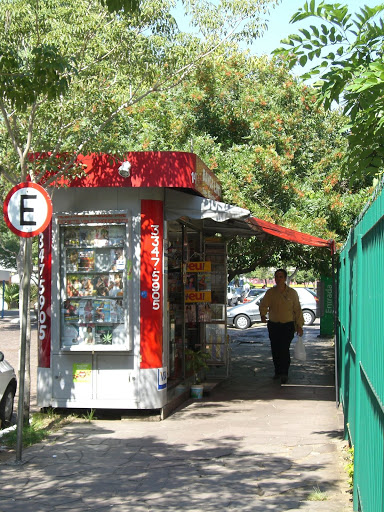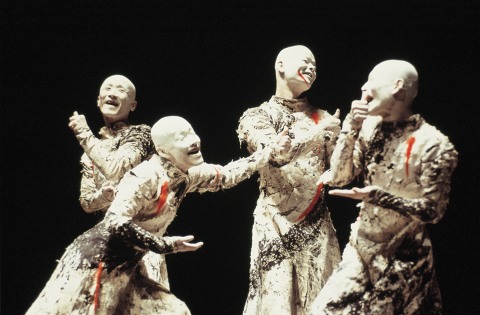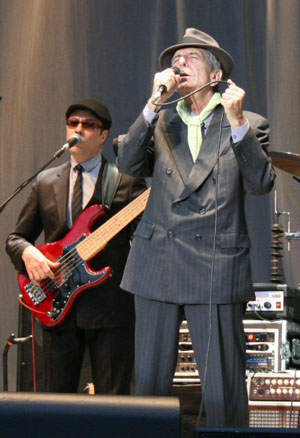skip to main |
skip to sidebar
I’m not a big architecture buff, but much of the feel of a place has a lot to do with it. My favorite aspect of Austin’s architecture are the balconies.
Most of the ones you see around town are big, roomy and inviting, and make for a great porch on the ground floor as well. Some of them are just a projection extending over the front door. Others surround the whole building, New Orleans-style, like the one at the Stephen Austin Hotel on Congress and 7th or the Starbucks on 24th and San Antonio.

Many UT buildings have small balconies, which are not really meant for extended hours outdoors, but mostly for decoration purposes. Those are common in Brazil, because of the influence from Portuguese architecture. But even the ones that are made for actual use are usually much smaller than what we see around here.

Typical Porto Alegre balcony

These ones are common in older Porto Alegre buildings
The Southern-style balconies we see around here are as stylish as they are convenient as shelter against the rain (and the scorching noon desert sun out here, too). Now that my time to go back home is approaching, they are one of the many simple things I've grown accustomed to around here that I'm beginning to miss, already.

You can tell a lot from the picture above. The degree to which Austin embraces the Longhorns and UT is hardly matched anywhere else I’ve ever been.
If you think about it, that orange and white symbol is a trademark that belongs to a “product” – the UT football team. But the success of that team, and of the university as a whole, has made them so popular that they are a part of the city’s identity. Most t-shirts, caps and other products you can find around Austin bearing the symbol are not affiliated with the University at all. It’s already striking that you find the Longhorn symbol on walls inside stores and restaurants, but to find it on the street signs is even more remarkable. In Brazil, that’s the kind of thing that would generate controversy, with many people complaining that the signs have been turned into advertising media. And that would probably happen here as well, if it was two golden arches or a white apple instead of a bull’s head next to the street name. It is no longer seen as just a sports thing: it’s part of Austin’s identity.
Of course, sports are a big part of it – Austin still stops to watch the big games, whether on TV or at the Darrel K. Royal Memorial Stadium. But people are pretty fanatical about sports in Brazil, too, and you don’t see that sort of identity correlation. I’d be tempted to say that the Longhorns are the official Austin team, but their only official affiliation is with the university. They are not even the only team in town, with A&M and Huston-Tillotson shaking up some serious dust in their games as well. Porto Alegre, for instance, is divided by the rivalry between the two local soccer teams, Grêmio and Internacional. But you don’t see their logos anywhere other than their stadiums, merchandise stores and fans t-shirts. The longhorns, on the other hand, seem to have long ceased to be a mere team, being now an institution in the city.
The last time it rained in the live music capital of the world was...precisely two months ago! Creepy!
How do I know? Because I blogged about it.
Today's rain was a bona fide Rio Grande do Sul shower: not only it was heavy, but windy -- i.e., the rain falls down at a 45-degree angle, and you have to adjust your umbrella accordingly. Not that it matters much, because that angle leaves your knees unprotected, meaning that your shins will be drenched for the day.
The Rio Grande do Sul anthem ends with a triumphant "Sirvam nossas façanhas de modelo a toda a Terra" ("May our feats serve as a model for the whole Earth"), but I wish this particular one went by unnoticed. The water pooling up by the curbs, the cars squirting water on your legs, the wind folding your umbrella upwards...if you've been rained upon in Austin, Porto Alegre wouldn't offer you many surprises, weatherwise. Except that it rains more often.
Plenty of lightning today, too. You might want to consider rubber soles, just in case.

The newspaper boxes are yet another quaint little image of Austin life that seems to come straight out of the movies for foreign eyes. Whether paid or free (and we don’t have as many of either), Brazilian non-subscribers still buy their newspapers in newsstands and convenience stores.
I’ve got this class called “Magazine Management”, where we study what’s involved in putting a magazine together and marketing it, and I had one of those moments when something obvious you hadn’t realized suddenly hits you in the face: there are no newsstands in Austin. The term “newsstand sales” is still the industry jargon to refer to non-subscription sales of a magazine or newspaper, but there are hardly any actual newsstands left out of New York, Boston and Chicago. In the Western part of the country (meaning West of the Mississippi and South of the Ohio River – i.e., more than three quarters of the continental US), people get their periodicals either at their door or seconds before checkout at grocery stores.

Newsstand in Porto Alegre, Brazil
There’s more than just nostalgia around the vanishing newsstands: the core implication in their extinction is that people walk less, doing most of their business out of the house by driving. A lot of human interaction is lost when shopping means parking, going through store aisles followed by the echoes of your footsteps, sliding your card at the checkout and getting back to your car.
I think the newspaper box is something to be treasured: it is the middle ground between East and West in the US.
 I'm still hyperventilating with the Cohen New Works Festival, the biennial theater festival held by UT's department of Theater and Dance to showcase new plays, many by the department's graduate students. This year, it was held between March 30th and April 4th.
I'm still hyperventilating with the Cohen New Works Festival, the biennial theater festival held by UT's department of Theater and Dance to showcase new plays, many by the department's graduate students. This year, it was held between March 30th and April 4th.
The peak of the cultural calendar in my native city of Porto Alegre is with no doubt Porto Alegre em Cena, our own annual theater festival that always presents some fifty or sixty plays, including local, national and international acts. The first performances to sell out are always the international ones, which over the years have included household names such as Peter Brook, Philip Glass, Pina Bausch, Stephen Berkoff, Laurie Anderson, Sascha Walts, La La La Human Steps, La Fura Dels Baus, Goran Bregovich, Sankai Juku and many others. It's a great opportunity to see bold, innovative works from around the globe. For a bargain, too: because the festival is funded by the City Hall and big corporate sponsors, tickets for individual plays cost less than ten dollars.

I haven't missed a single edition of Porto Alegre Em Cena since 1999 -- except for last year, because I was in Austin. It's really a shame I couldn't do both, but all is well that ends well: the Cohen New Works Festival filled that gap for me. While it did not include the impressive roster of worldwide artists and or as many plays (a total of 30), this year's NWF owed nothing to the degree of sophistication, innovation and variety that we are used to seeing during Em Cena. Many of the plays had a very ambitious experimental focus -- and I don't mean that in the sense of brainy, self-indulgent intellectual snoozefests for the sole enjoyment of the artists themselves: the plays I saw were fun. Exciting. Captivating. Just like the best theater always is.

Legendary Japanese dance-performance group Sankai Juku performed at Em Cena in 2007(Ok, not all of them. But that's a good thing. Both festivals have had their share of hits and misses, but that's a good thing too: it shows that people are taking risks, instead of playing it safe with proven formulas. Personally, I don't mind bad plays, films, songs, fiction or any other work of art. They help you put the good ones in perspective.)
NWF highlights included The Psyche Project, a modern reading of the story of Eros and Psyche where Eros upgraded his bow and arrows into an automatic pistol and Hell is a shopping mall; Funky Snowman, a short play for children where a girl who cannot succed in her ballet classes learns the groove of pop music from a talking snowman; The Edge of Peace, a dramatic reading of Susan Zeder's last installment in her award-winning "Taste" trilogy; and, last but not least, the tongue-in-cheek examination of women's magazines in the collaborative, comically-titled 101 Ways To Get The Perfect Look, Have Hotter Sex, Love Your Body, Dress A Whole Lot Cooler, Make Your Boobs Pop, Be More Adventurous, Be More Cautious, Smell Better, Feel Less Guilty, Read His Mind, Make Him Notice You, Make Yourself Over, Spend Money Better, Get Smarter By Tomorrow, Connect With Your Kids, Be A Hipper Dancer, Have More Fun, Share Your Deepest Darkest Secrets, Recycle!, Find Your Inner Self And Do Anything Better.
Rounding up the roster of bold, intriguing performances was a selection of short films from UT's RTF students with a variety of styles, tones and even languages.
I'll eventually go back home and enjoy Porto Alegre Em Cena again. But now I'm gonna miss the Cohen New Works Festival, too. Perhaps I can get some discounted air tickets for non-profit drama events or something.

Only in Austin you can find out Jerry Seinfeld is performing later in the day and still get tickets to see it. That's just what I did.
His performance tonight at UT's Bass Hall was very much what you see him do in the opening vignettes from his homonymous sitcom: pointing a deadpan, sardonic finger at the irrational and the banal in the lives of Americans, targetting everything from marriage and children to iPhones and public restrooms. For what it's worth, it's as funny as. And if you've followed his series as long as I have, you get the extra fun of listening to people as they throng out of the theater and realizing where Seinfeld gets his inspiration for. For instance, you hear people saying things like "see you" and "take care," and remember that episode in Season 2 where his end joke went like this:
"Take care now." Did you ever say that to somebody? "Take care now. Take care, now. Because, I'm not going to be taking care of you. So, you should take care, now." "Take care. Take care." What does this mean? "Take off!" Isn't that what you really want to say?
Just for the record, I googled this quote. I'm not that nerdy (or I am, but have a bad memory).
Favorite joke from tonight's performance: "Now walkers have wheels, and even brakes in the handles. How fast are these people going? If you're going fast enough to need brakes, perhaps you've been misdiagnosed."
PS: Kind of a Hebrew week we're having here in Austin, aren't we? Mazeltov!

So said Leonard Cohen in the middle of his timeless hit “Hallelujah” tonight at the Long Center. He’s touring the US for the first time in fifteen years, and I’ll tell you, it was worth the wait.
The whole gig lasted close to three hours – with six encores. Six piece band (including Austin-born Roscoe Beck, bassist and musical director of the tour), plus three backing vocals (including Sharon Robinson, Cohen’s composition partner for more than twenty years). It was lively, unpredictable and intense. A concert to remember.
Cohen’s voice sounds exactly like his records. Being a huge fan for a couple of years now, my first thought when I heard him thanking the audience and coming up with playful banter in between songs was “it speaks, too!” If you watch the Live in London DVD that was released just now, on March 31st, rest assured that that is the sound you hear live. No tricks.
Other than “Hallelujah,” the highlights of the show were “Who By Fire” and “The Partisan,” with much more complex and lively instrumentation than the studio versions; “Democracy,” fleshed out with verve and enthusiasm into a live anthem; and “First We Take Manhattan,” which prompted everyone to clap along and yell as Cohen adlibbed his famous chorus into a playful “then we take Beijing.” Two unexpected songs from his early years made their way into the setlist: “Hey, That’s No Way To Say Goodbye” and “Famous Blue Raincoat” (this one a little over the top – the six-piece-band treatment overshadowed the intimist melancholy of the song).
Believe the hype. This concert is as good as the press is making it out to be.









